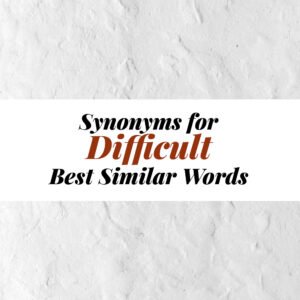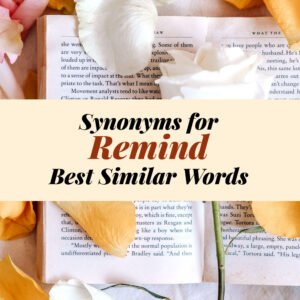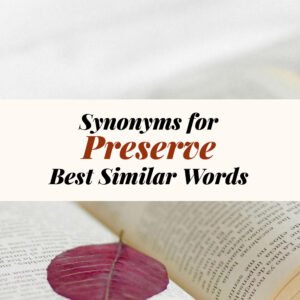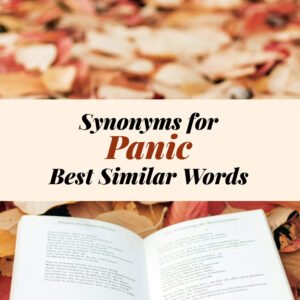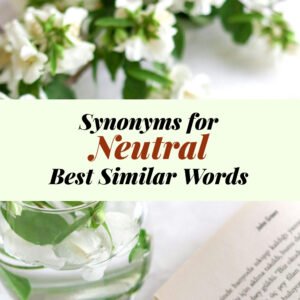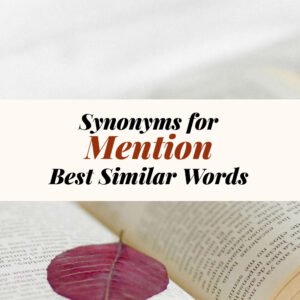Feeling calm is something everyone wants in life. Calm means being peaceful, relaxed, or not worried. Many times, we want to express calm in different ways. Words like serene, composed, relaxed, and tranquil are a few examples. Using other words for calm can make your writing or speech more interesting. In this article, we will explore 23 different ways to say calm with examples and explanations to help you understand and use them easily.
| Synonym | Meaning | Example |
|---|---|---|
| Serene | Very peaceful and untroubled | She felt serene while watching the sunset. |
| Tranquil | Free from disturbance | The lake was tranquil in the morning. |
| Peaceful | Quiet and calm | He enjoyed a peaceful walk in the park. |
| Composed | Not showing stress or emotion | She remained composed during the meeting. |
| Relaxed | Free from tension or worry | He looked relaxed after the massage. |
| Placid | Calm and undisturbed | The placid river reflected the sky. |
| Collected | Calm and in control | Despite the chaos, she stayed collected. |
| Cool-headed | Calm and able to make decisions | He stayed cool-headed during the crisis. |
| Content | Happy and calm with life | She felt content after finishing her work. |
| Untroubled | Free from worry or stress | He led an untroubled life in the countryside. |
| Restful | Giving rest or calmness | The restful garden made her smile. |
| Gentle | Mild and calm in behavior | He had a gentle voice that soothed everyone. |
| Mild | Not harsh, soft | The mild weather made the day enjoyable. |
| Balanced | Calm and stable emotionally | She has a balanced approach to challenges. |
| Harmonious | Peaceful and friendly | Their relationship was harmonious and strong. |
| Pacified | Made peaceful | The mother pacified the crying baby. |
| Nonchalant | Calm without concern | He seemed nonchalant about the problem. |
| Cool | Calm under pressure | She stayed cool when everyone panicked. |
| Poised | Confident and calm | He looked poised before giving his speech. |
| Collectedness | Quality of being calm | Her collectedness helped solve the issue quickly. |
| Unflustered | Not upset or worried | She remained unflustered despite delays. |
| Sedate | Calm and dignified | The sedate atmosphere of the library was welcoming. |
| Quiet | Calm and not noisy | The quiet room helped him concentrate. |
23 Different Ways to Say CALM: Another Word for CALM
Serene
Serene means very peaceful and without any trouble. When someone or something is serene, there is no stress or disturbance. You can use serene to describe nature, a person’s mind, or a situation. People often feel serene when they are alone in a quiet place or after solving a problem. It shows a deep level of calm that comes from within. Being serene can help you make better decisions and feel happy. Everyone can try to practice being serene by focusing on positive thoughts or enjoying quiet moments.
- She felt serene while watching the sunrise.
- The serene park made everyone relax.
- He had a serene expression during the meeting.
Tranquil
Tranquil means completely free from disturbance and stress. It is often used to describe places like lakes, gardens, or rooms, but it can also describe people’s feelings. A tranquil mind is calm and peaceful. Spending time in tranquil places can help reduce stress and improve your mood. You can use tranquil to describe moments when everything feels quiet and balanced. People often seek tranquil environments when they want to think clearly or feel comfortable. Tranquil is a word that shows total calm and stillness in both life and nature.
- The lake was tranquil in the morning.
- She spent a tranquil afternoon reading a book.
- The tranquil garden helped him feel relaxed.
Peaceful
Peaceful means calm and quiet, without noise or problems. It can describe people, places, or situations. A peaceful person does not get angry easily and handles stress well. Peaceful places are often quiet and give comfort to anyone there. You can create a peaceful environment by keeping your surroundings clean, soft music playing, or sitting quietly. Being peaceful makes you feel good and helps others around you stay calm. Peaceful is a common and useful word to show calmness in life and relationships.
- He enjoyed a peaceful walk in the park.
- The peaceful morning made her smile.
- Their peaceful home helped everyone relax.
Composed
Composed means being calm and not showing stress, worry, or strong emotions. A composed person can handle difficult situations without panicking. Being composed helps you make better decisions and stay confident. Composed people are admired because they can stay strong even under pressure. You can become composed by taking deep breaths, thinking before speaking, and staying focused. Using composed in writing or speaking shows that someone is self-controlled and calm. It is a good word to describe mental strength and inner calm.
- She remained composed during the interview.
- He stayed composed while solving the problem.
- The teacher was composed despite the noisy classroom.
Relaxed
Relaxed means free from tension or worry. It can describe a person’s body, mind, or atmosphere. Relaxed people feel good, comfortable, and happy. Being relaxed can help you sleep better, think clearly, and enjoy life more. People often relax by sitting, lying down, taking a walk, or listening to music. Relaxed is also used to describe places like spas, homes, or gardens that help you feel calm. When you are relaxed, it shows that you are at ease and ready to enjoy the moment.
- He looked relaxed after the massage.
- She felt relaxed during the quiet afternoon.
- The relaxed atmosphere helped everyone focus.
Placid
Placid means calm, peaceful, and undisturbed. It is often used for lakes, rivers, or places, but it can also describe people who are not easily disturbed. A placid person stays calm even when problems happen. Being placid can help you think clearly and act wisely. Placid can also describe the mood or atmosphere, showing that everything is calm and steady. Practicing patience and taking slow, deep breaths can help you become more placid. It is a valuable word to describe both nature and human behavior.
- The placid river reflected the blue sky.
- She remained placid during the argument.
- The placid garden made him smile.
Collected
Collected means calm and in control, especially during stressful situations. A collected person does not panic and can think clearly. This word is often used for people who face challenges or difficult events with confidence. Being collected helps you make the right choices and stay strong. You can practice being collected by preparing in advance and staying focused on your goals. Using collected shows that someone is organized, steady, and calm inside. It is a very useful word for describing emotional strength and mental calmness.
- Despite the chaos, she stayed collected.
- He remained collected while giving the speech.
- The collected student solved the problem calmly.
Cool-headed
Cool-headed means staying calm and able to make decisions even under pressure. A cool-headed person does not get angry or anxious easily. This quality is important in emergencies, work situations, or conflicts. Being cool-headed helps you think clearly and act wisely. You can become cool-headed by practicing patience, thinking logically, and controlling your emotions. Cool-headed is often used in stories, news, or daily life to describe someone strong and calm. It shows mental stability and the ability to handle pressure effectively.
- He stayed cool-headed during the crisis.
- The cool-headed driver avoided an accident.
- She remained cool-headed while others panicked.
Content
Content means being calm and happy with what you have. A content person does not worry too much or feel jealous. Being content helps you enjoy life and feel peaceful. Content can describe a feeling, mood, or life in general. You can practice contentment by appreciating what you have, staying positive, and avoiding unnecessary stress. Being content does not mean lazy; it means balanced and satisfied. Content is a useful word to describe inner calm and happiness in daily life.
- She felt content after finishing her work.
- He was content with his simple life.
- The family felt content during the holiday.
Untroubled
Untroubled means free from worry, stress, or problems. An untroubled person feels calm and relaxed. This word can describe life, mind, or feelings. Being untroubled helps you stay focused, happy, and peaceful. You can practice being untroubled by solving problems one by one and not worrying about things you cannot change. Using untroubled shows a state of calm and ease. It is useful when describing someone’s personality or a peaceful life. Untroubled is a gentle word to show complete calmness.
- He led an untroubled life in the countryside.
- She remained untroubled despite the challenges.
- The untroubled child played quietly.
Restful
Restful means giving rest, calm, and peace. A restful place, person, or activity helps you feel relaxed and comfortable. Restful sleep, gardens, or music can improve your mood and reduce stress. Restful shows calmness in the environment or inside you. Practicing restful moments every day can make life better. You can rest by sitting, closing your eyes, or enjoying nature. Using restful describes peace, calm, and comfort in life. It is a soothing and useful word to express calmness.
- The restful garden made her smile.
- He had a restful night of sleep.
- The restful music helped him focus.
Gentle
Gentle means calm, mild, and not harsh. A gentle person is kind, soft, and peaceful. Gentle actions or words make others feel safe and comfortable. Being gentle helps you build good relationships and stay calm yourself. You can be gentle by speaking softly, moving slowly, and showing care. Gentle is a useful word to describe people, voices, movements, and behavior. It shows calmness in actions and feelings, making life better for everyone around you.
- He had a gentle voice that soothed everyone.
- She was gentle with the little animals.
- The gentle breeze cooled the room.
Mild
Mild means calm, soft, and not strong or harsh. Mild can describe weather, personality, or actions. A mild person does not get angry quickly and stays peaceful. Mild weather, food, or events can make people feel comfortable and relaxed. Using mild shows calmness without stress or tension. You can practice being mild by staying patient, speaking softly, and avoiding harsh words. Mild is a useful word to describe calm and gentle things in life.
- The mild weather made the day enjoyable.
- He had a mild attitude toward problems.
- The mild music helped her relax.
Balanced
Balanced means calm, stable, and in control of emotions. A balanced person does not get stressed easily and makes wise decisions. Balanced life, mind, or feelings help you feel peaceful and happy. You can practice being balanced by managing work, rest, and emotions carefully. Balanced is an important word to describe calmness and wisdom. It shows that someone can handle life situations without panicking or overreacting. Using balanced makes people feel confident about someone’s calm and steady nature.
- She has a balanced approach to challenges.
- He felt balanced after meditation.
- The balanced teacher managed the class well.
Harmonious
Harmonious means peaceful, friendly, and in agreement. Harmonious people, places, or relationships show calmness and cooperation. Being harmonious helps reduce stress, conflicts, and tension. You can be harmonious by listening to others, staying patient, and avoiding arguments. Harmonious is a strong word to describe calm and friendly situations. It shows balance and peace in life. Using harmonious makes communication, relationships, and environments better and stress-free.
- Their relationship was harmonious and strong.
- The harmonious team worked well together.
- The harmonious garden gave joy to visitors.
Pacified
Pacified means made peaceful or calm. A pacified person, baby, or place is no longer upset or angry. Pacifying helps bring calm and reduces stress. You can pacify someone by speaking gently, listening, or helping solve problems. Pacified is a useful word to describe peace after tension. It shows control and calmness after a disturbance. Using pacified makes situations or people relaxed and happy. It is helpful when talking about calming emotions or situations.
- The mother pacified the crying baby.
- The manager pacified the angry clients.
- The pacified village enjoyed peace again.
Nonchalant
Nonchalant means calm without showing worry or concern. A nonchalant person does not react strongly to problems or stress. It shows confidence and relaxed behavior. Being nonchalant can help reduce stress and make life easier. You can practice being nonchalant by not overthinking and staying positive. Nonchalant is useful to describe someone who is calm under pressure. It shows strength, confidence, and emotional control in a gentle way.
- He seemed nonchalant about the problem.
- She was nonchalant during the stressful day.
- The nonchalant student ignored distractions.
Cool
Cool means calm, composed, and not nervous under pressure. Cool people do not panic and stay relaxed. It is often used in emergencies, work, or public speaking. Being cool helps you think clearly and act wisely. You can become cool by staying focused, controlling your emotions, and practicing patience. Cool is a strong and common word to describe calmness in behavior and mind. Using cool shows confidence and self-control in all situations.
- She stayed cool when everyone panicked.
- He kept cool during the tough exam.
- The cool manager solved the problem easily.
Poised
Poised means calm, confident, and ready to face any situation. Poised people remain steady under stress and show control. Being poised helps in public speaking, work, or daily life. You can practice poise by staying calm, confident, and focused. Poised shows mental strength and calmness. It is a valuable word to describe someone who handles situations gracefully without panic. Using poised makes you appear confident and calm to others.
- He looked poised before giving his speech.
- She remained poised despite the crowd.
- The poised student answered all questions calmly.
Collectedness
Collectedness means the quality of being calm and in control. It is the ability to stay steady under stress. People with collectedness can handle problems, emotions, and challenges without panic. Practicing deep breathing, patience, and focus increases collectedness. Using collectedness shows inner calm, strength, and self-control. It is often admired and respected in work, personal life, and learning situations. Collectedness is a strong word to describe calm behavior that stays consistent even under pressure.
- Her collectedness helped solve the issue quickly.
- He showed collectedness in the difficult situation.
- The collectedness of the team impressed the manager.
Unflustered
Unflustered means calm and not worried even when problems occur. An unflustered person stays composed and does not panic. It shows control over emotions and mind. Being unflustered is useful in work, studies, or daily life. You can practice being unflustered by staying focused, thinking clearly, and not reacting too quickly. Using unflustered shows calmness, patience, and confidence. It is a good word to describe people who stay relaxed under pressure.
- She remained unflustered despite delays.
- The unflustered driver handled traffic calmly.
- He stayed unflustered during the storm.
Sedate
Sedate means calm, dignified, and peaceful. Sedate places, people, or activities are quiet and relaxed. Being sedate helps reduce stress and feel comfortable. You can become sedate by sitting quietly, breathing slowly, and focusing on calm thoughts. Sedate shows control and steadiness in behavior. Using sedate describes calm environments and people who act without rush or panic. It is useful for describing quiet and peaceful situations in life.
- The sedate atmosphere of the library was welcoming.
- He moved in a sedate and careful way.
- The sedate music helped her focus.
Quiet
Quiet means calm, not noisy, and peaceful. Quiet places and people create comfort and reduce stress. Being quiet helps you think and relax. You can practice quiet by reducing noise, speaking softly, and enjoying still moments. Quiet is a common word for calmness and peace. It shows stillness and control in both environment and mind. Using quiet is helpful for describing situations, rooms, and behavior that promote calmness.
- The quiet room helped him concentrate.
- She enjoyed the quiet morning.
- The quiet child played without disturbing anyone.
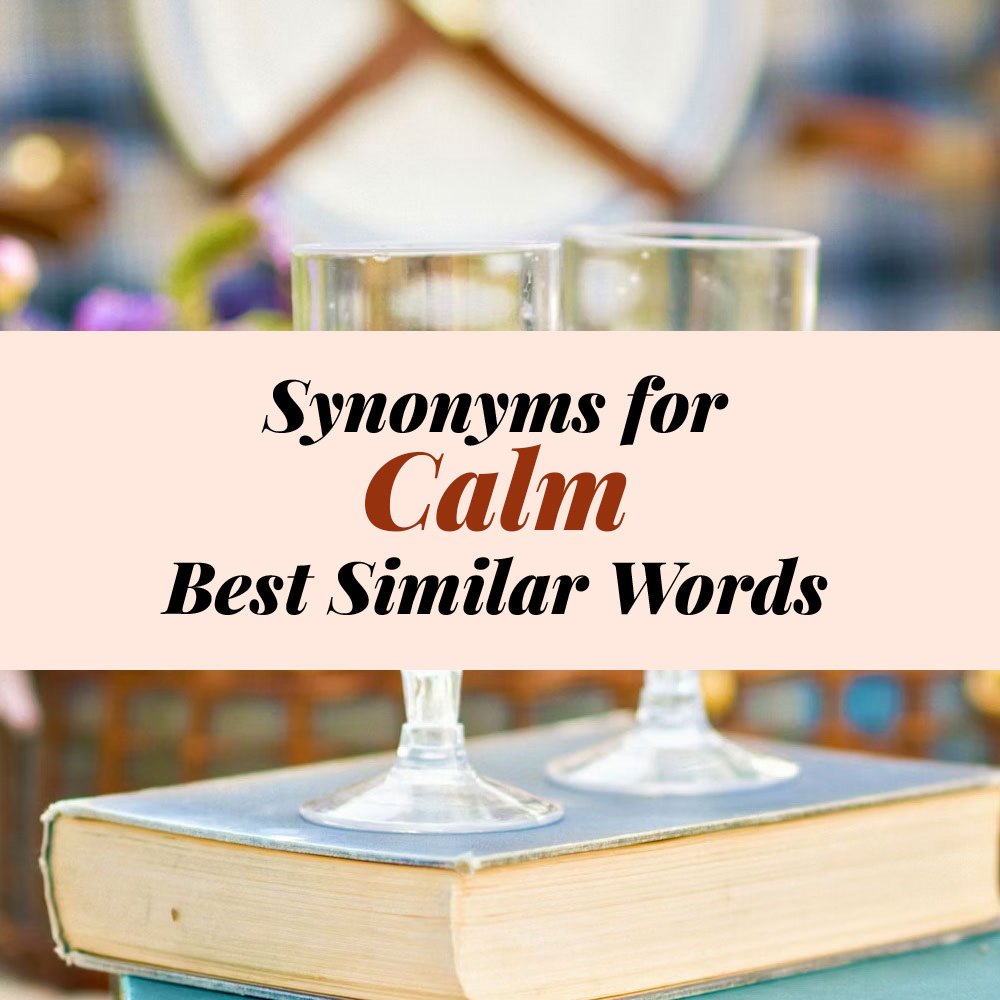
Final Thoughts
Using different words for calm helps make communication more interesting and precise. Words like serene, composed, and tranquil describe many kinds of peace. Learning these words improves how you express emotions and situations. Practice using them daily to enhance your calm and confident communication.
